This year the man will stand upon a many-chambered maze, a carnival of consciousness housing a freak show of the self. Each interactive room will contain an art installation indicating a different mood, a different mask; a different mode of being we assume as players in the masquerade that’s called a personality.
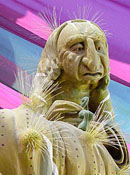 Advice from a Caterpillar
Advice from a Caterpillar
by Emma Hardy
This project is a larger than life opportunity to receive some advice from an enormous, colorful, hookah-smoking caterpillar. While sitting upon their own mushroom, the participant has the freedom to select thematic offerings from the caterpillar via colorful buttons within the numerous mushrooms scattered over the display. The advice will be in various forms and themes including words of wisdom from Dr. Seuss, mixed tunes/vocals, and the spoken word. The caterpillar and mushrooms will be enhanced with fiber optic lights plus blacklight highlights.
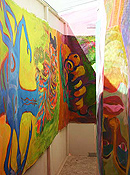 Catacomb of the Exquisite Corpse
Catacomb of the Exquisite Corpse
by Mark Van Proyen and SFAI Students
Students from the San Francisco Art Institute worked collaboratively to create twenty six 5′ X 12′ murals on canvas.
Collective Mind
by Carmon Emery
Dreams are the conversations our psyche has between our waking lives and our non-waking lives. In these dreams appear seven archetypes that guide us and bring unity to our souls. Each archetype is a fragment of our complete self, and by identifying with all seven, we can achieve psychic unity. This, in turn, allows us to delve deeper into the creative power of our collective unconscious. Passers-by will be able to stop and view themselves through each individual archetype (or collectively) with the hope of finding their own psychic unity.
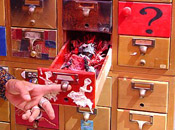 Curiosity Cabinet of the Collective Unconscious
Curiosity Cabinet of the Collective Unconscious
by The GVP and Co.
A curiosity cabinet built out of old card catalogs offers 30 interpretations and various definitions of the unconscious.
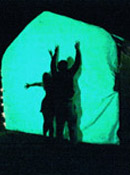 Glow Theatre
Glow Theatre
by Amy Shapiro
Participants stand and pose against the glow-in-the-dark walls of Glow Theatre while 500-watt lights are briefly turned on, charging the paint with light so it glows. Step away, turn around, and your shadow is frozen onto the wall. The image fades in a few minutes and the next pose automatically erases the previous pose. Groups of people can use the Theater to create descriptive tableaux which tell stories or to create abstract patterns. The glow paint walls can also be drawn or written on using flashlights.
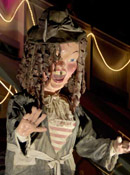 Laughing Sal
Laughing Sal
by Dana Albany
At the entrance to the Funhouse will be a recreation of the infamous “Laughing Sal”, a full-bodied, slightly maniacal lady with a boisterous, hysterical and contagious laugh. At her base will be three stationary bikes, which when pedaled by participants will make Sal move and laugh. There will also be four interactive clown facades in her vicinity, that will reveal different aspects of the psyche underneath.
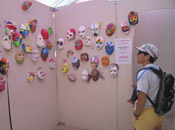 Masks of Id
Masks of Id
by the House of Masks
Masks representing the self created by visitors to this theme camp hang on the second floor of the Funhouse.
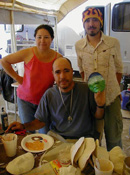 Me and Myself
Me and Myself
by Arody Garcia, Lenin Marqueaz and Elina Chauvet
This artist’s group from Mexico will make 2-300 masks of participants, taking a mold of their faces, casting them in paper pulp, and painting them. The first casts will be displayed in the Funhouse, and subsequently cast masks will be decorated and worn by participants.
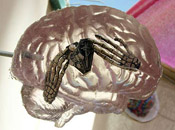 Mind Field
Mind Field
by Cheryl Anderson
Clear arcylic brains contain images that represent thoughts, phobias, and experiences. The brains represent an individual thought, or grouped together represent a connection of thoughts; an image clear by day may become distorted at night. Lighting represents neurons firing within a brain. The Mind Field provokes participants to explore, ask questions o
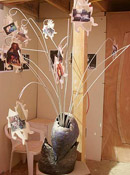 Oh, My Head
Oh, My Head
by Sara Chieco
Exploding from this ceramic representation of a brain are pieces of the artist’s consciousness, and opportunities for the observer’s self-reflection.
 Paintings
Paintings
by Hugh D’Andrade
Several paintings on canvas by Hugh, Burning Man ticket and postcard designer, adorn the exit room.
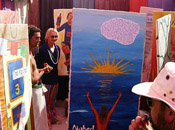 Playa Cards
Playa Cards
by Red
Playa Cards are a vehicle used by the unconscious mind to communicate with the conscious mind. One can discover what is really going on in one’s psyche by interacting with this powerful 12-card stonehenge.
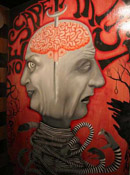 Psych Show Freaks
Psych Show Freaks
by JennyBird Alcantara
An eight painting series of the psychic freakshow frames the entrances to the Funhouse.
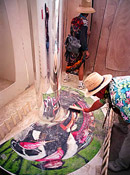 Psyche’s Mirror
Psyche’s Mirror
by Ray Allen
Psyche’s Mirror is an anamorphic art piece — it uses a curved mirror to change the view of a distorted image into an undistorted image.
 Rorschach Room
Rorschach Room
by Jason Fitzgerald
Derived from the famous projective tests using bilaterally symmetrical inkblots to derive an insight to the subjects’ personality and intelligence, the Rorschach room features back-lit screens with hundreds of individual rorschach images, covering the walls, the ceiling and the floor.
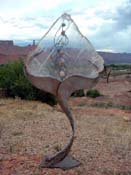 Selenite Psychic Shift Key
Selenite Psychic Shift Key
by Krista Guss and Stoke Dunton
The Selenite Psychic Shift Key is an experiment in psyche. There are three levels of energetic interactivity with the Selenite (petrified ice). (1) Individual Consciousness – the Joy Mirror (2) Collective Consciousness – Universal Shift Register (3)The Man’s Consciousness – Psychic Shift Key.
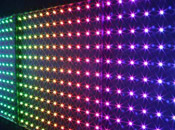 Synoptic Reflections
Synoptic Reflections
by Carl Gruesz
The optic nerve is a part of one’s consciousness, and has a strong yet mysterious influence on the psyche. Impressions of light and color trigger a cascade of reactions at all levels of consciousness. Entry into this space triggers a reaction to one’s presence. With a subtle glow, the room sends out synoptic messages as tiny lights whoosh past. Retinal impressions appear, bigger than life, reflecting infinitely. The presence of others in this interactive space intensifies the photonic activity.
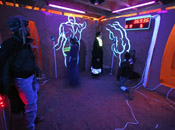 The Laying on of Hands (Plato’s Cave Version)
The Laying on of Hands (Plato’s Cave Version)
by Mark Madel with mural design and painting by Mark Melnick
This is a room/cave inside the mind which represents the past, present, and future; the child, female, and male, and the generative, the nurturative, and the destructive. Without any participants engaged, it is inhabited only by disconnected slices of the personality, or isolated shadows from the past – but up to nine people can participate simultaneously to create a fusion, to drive away the ghosts, and to provide the human interaction needed for becoming. The room, like many of us, has quite a different persona by night than by day, so one should not be surprised to see layers hidden or stripped away by the change.
Tikal
by Paul David
From a nine-foot dream catcher hang spheres made of eight more dream catchers, with four concentric hoops in the colors of the Medicine Wheel, containing male and female effigies.
 True Mirror Palace
True Mirror Palace
by John Walter
The True Mirror Palace is a magical place of inner discovery and outer enlightenment, as one’s true nature is matched with the view of one’s self when seen in a mirror. The True Mirror is a mirror that doesn’t reverse-images; in other words, you can see yourself as you are, instead of the backwards view you get in every other mirror! Using special front surface mirrors and precise angling, the images created are optically perfect. The Palace consist of two large full length mirrors setup in the corners, plus up to seven smaller True Mirrors at various heights. The inner mirrors give individuals a chance to sit or stand in front of one by themselves or with a partner, and to explore their inner nature in semi privacy. As a special treat, an “infinity mirror” will be present, made with True Mirrors… the effect is astonishing, since the reflections go off in a crystalline pattern.
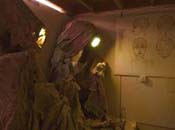 Uncanny Arachnid Presence/Response
Uncanny Arachnid Presence/Response
by Tyson Phipps
Here are three looming sculptures, crafted to resemble empty capes – twisting, gestural and organic. The void of the facial socket is an oculus: brightly streaming light. Each figure holds aloft a brightly jocular Venetian-style harlequin mask. The three figures will focus their light sockets upon a central portion of the room, indicating and inviting the viewer to stand within the loose circle of illumination. Upon arrival, the viewer notices their whitewashed reflection within the depths of the caped figures, seeing themself within these intimidating presences. Two-dimensional counterpoints to the sculptures hang from the walls between the Presences; these are diagrams of psychological responses and/or mental states of being. They are simple black and white paintings, indicating various attempts to diagram the human tendency to break down psychology into simple terms.
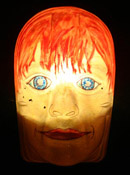 Voices in my Head
Voices in my Head
by Eric Griswold
In a dark tunnel, 24 mysterious faces speak – begging, commanding, pleading, and questioning. Participants will have the opportunity to transcend their internal dialogue and experience a Zen moment.

